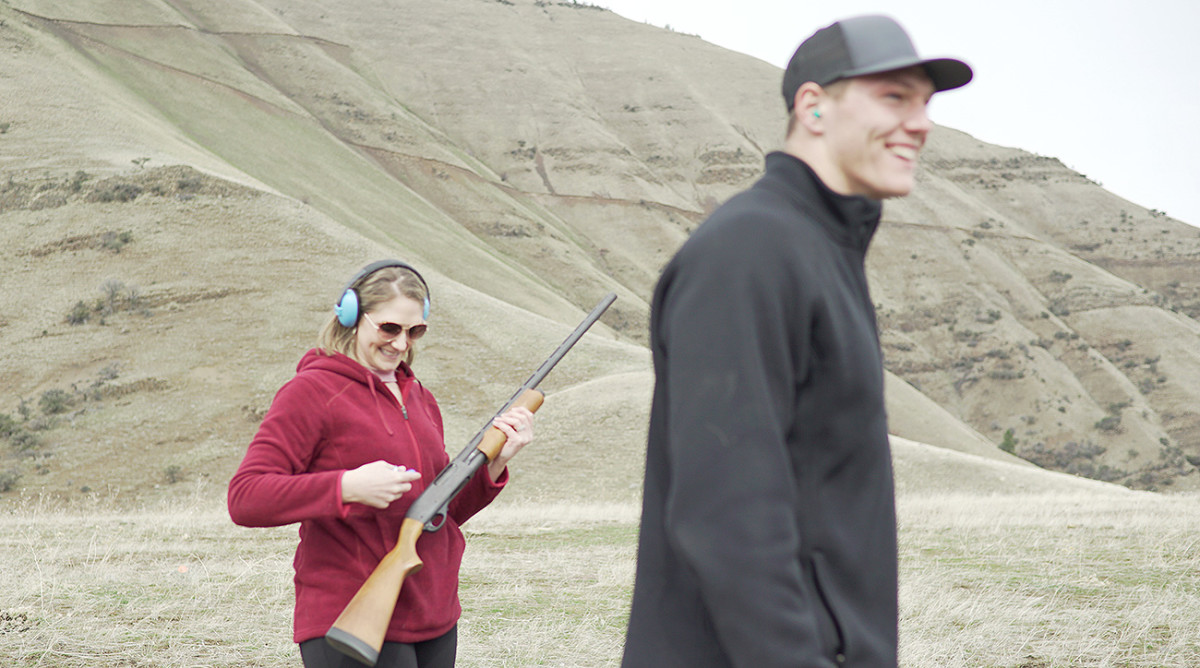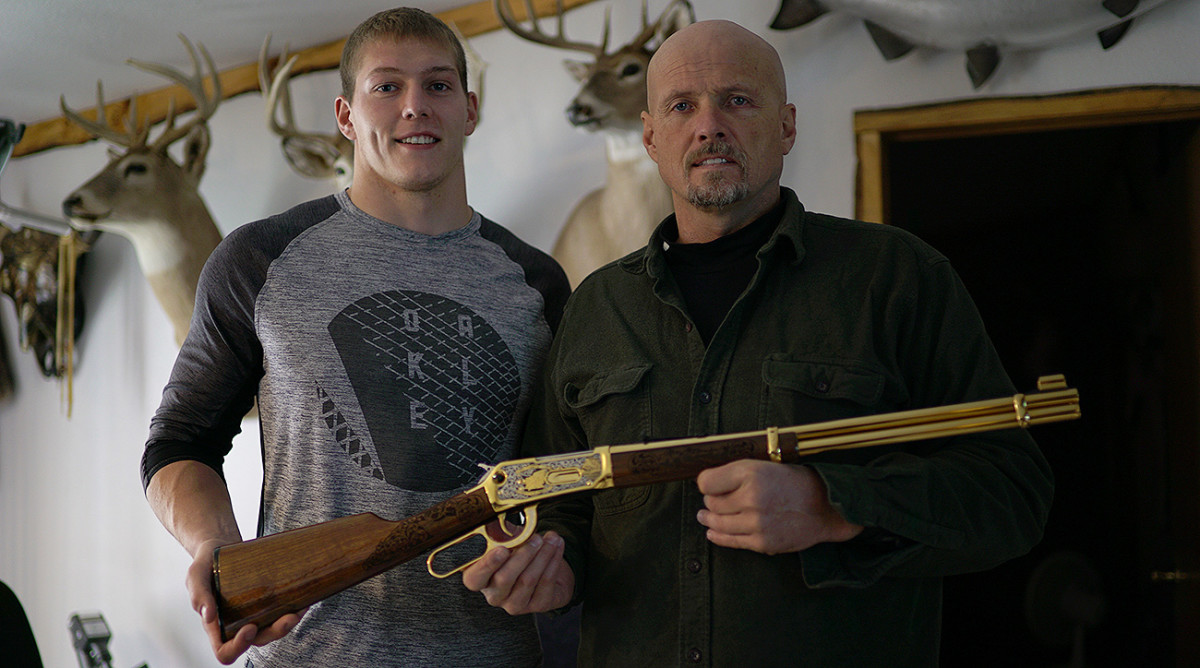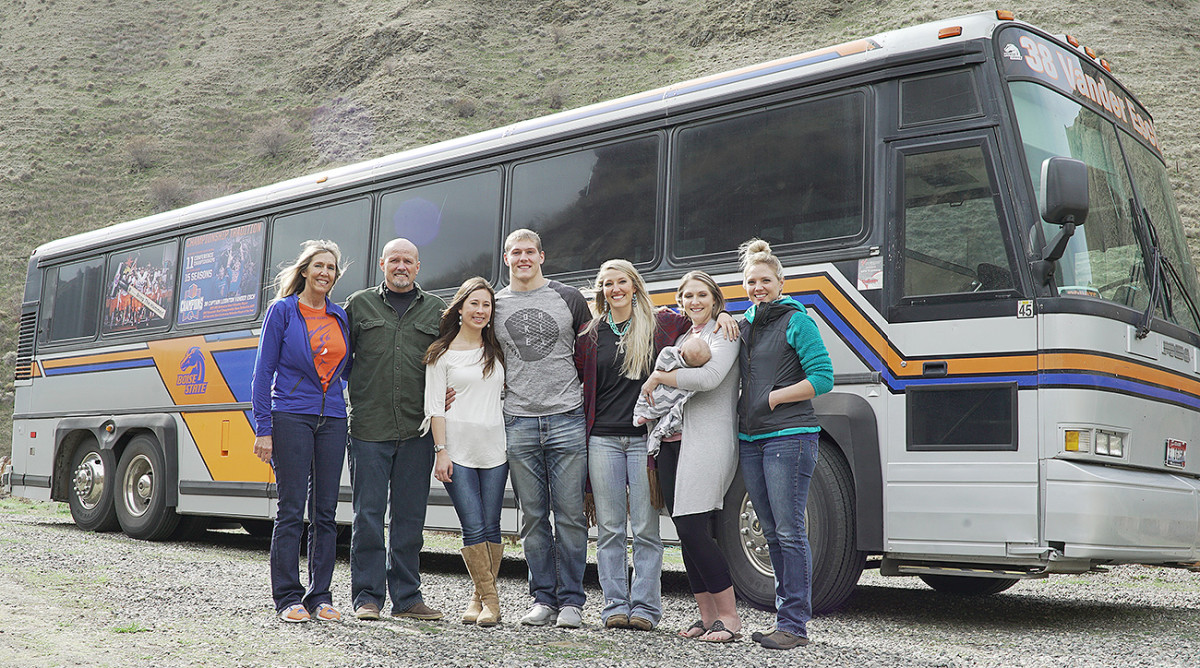From Small-Town Idaho to the NFL Draft, Leighton Vander Esch Ready to Take the League by Storm

AVAILABLE ON SI TV: Skeet shooting and river rafting were all part of Boise State LB Leighton Vander Esch’s upbringing. The NFL prospect introduces SI to the small Idaho mountain town where he was formed. You can now watch anytime, anywhere on SI TV.
I’m holding a 12-gauge shotgun, trying not to tremble. Leighton Vander Esch is over my shoulder, explaining how to fire it.
“Keep it snug, release the safety by pressing here,” he says.
The first-round linebacker prospect from Boise State and I are atop a small mountain on his family’s property, overlooking his hometown of Riggins, Idaho—population 419. The town is nestled in a canyon along the Salmon River, surrounded by mountains of sagebrush that turn into mountains of pine, rock and snow the higher you go. It’s a blustery spring day, with the temperature in the 40s. In the summer, temperatures along the river can climb to 110 degrees. In the winter, snowmobiling and downhill skiing are less than a 40-minute drive away.
We are joined by Vander Esch’s three older sisters: Shannon, Christon and Morgan, who are in their late 20s and early 30s. Back in Boise is Jason, the oldest child. Leighton, 22, is the baby. All the Vander Esch kids are blonde, athletic and without pretense. Their dad, Darwin (“I have my own theories,” he said upon introduction) is also on hand. Their mom, Sandy, is with Christon’s three-month old son back at the house, which sits near the bottom of the mountain and just off the main—and only—road that goes through Riggins.
Today we’re shooting orange clay targets that are shaped like saucers. The Vander Esches have called it both “trap shooting” and “skeet shooting”—either way someone throws the saucer in the air, and another person shoots it. (The family has a “trap thrower”—a device that fires the saucers higher and further, similar to how a jugs machine launches footballs, but Leighton accidentally left it in Boise, a three-and-a-half hour drive south of Riggins.)
Moments earlier, Leighton had fired some rounds, but saucer after saucer rose and fell unharmed, the poor start causing his face to redden. For the Vander Esch kids, shooting is almost as familiar as walking and talking; repeated misfires will earn you the same type of stares as tripping on your own feet or mispronouncing a common word. Leighton’s blush darkened after Christon took the gun and shattered a saucer on her first shot. She smirked ever so slightly and then simply said “pull”—the word a trap/skeet-shooter says when they’re ready for another saucer to fly. After she connected on her next two shots, Leighton reclaimed the gun, started throwing the saucers himself and found his rhythm. Every BANG brought shattered bits of orange clay to the ground. (The saucers are biodegradable, Morgan points out.) Normalcy restored.

The Vander Esch home is like a taxidermied zoo. Every room is decorated with hunting trophies, from elk, mountain lion, various deer, chamois, lynx and wolves. And in storage are more of these animals, plus black bears, brown bears and buffalo. Antlers are displayed all over, casually mixed in with family portraits, coasters and throw pillows. Where there’s not a dead animal there’s some sort of Boise State memorabilia. Leighton was the only kid who spent high school in this house; before that, the family lived about three minutes down the road, on the other side of the river.
Family friends bought that place and moved in in 2013, but you get the sense it wouldn’t be weird if a Vander Esch waltzed through their old front door without knocking. Almost everyone in Riggins knows everyone, and certainly everyone knows the Vander Eschs.
Darwin, a consummate patriarch, for 18 years has run a professional hunting business, first in Idaho, which he sold in 2010, and now Alaska, where he travels for two-month stretches in spring and fall. He’s a revered outdoorsman—and in Riggins, that’s the equivalent of being a renowned banker in New York or award-winning movie executive in Los Angeles. Darwin finds teaching moments in every situation, from explaining (with incredible thoroughness) what drives the seasonal geography of every surrounding mountain; to the history of any (maybe every) area of wilderness west of his hometown, Hawarden, Iowa; to the most nuanced mechanics of shooting, be it a gun or basketball. The constant pedagogy has left all the Vander Esch kids rich with knowledge and confidence, but when I ask if their childhoods involved lots of eye-rolling and Yeah, yeah, I got it, Dad!, Leighton laughs affirmatively, as if the answer is comically obvious.
Sandy was a noted basketball player growing up in Iowa and played an active role in her kids’ athletic development. Jason was a high school football player, all three sisters were basketball stars who went on to play at small colleges, and Leighton, with his unfathomably thick neck, has become the most famous person in the town’s history.

More than a quarter-million new players join high school football each year, and only 32 will go on to be first-round NFL picks. The fact that one of this year’s first-round prospects hails from almost the middle of nowhere (there are no highways northeast of Riggins for the next 150 miles) provokes the expected astonishment, especially when you consider that the town’s Salmon River High School plays in an eight-man football league. The first time Vander Esch started a game against an 11-man offense was as a junior at Boise State; his first NFL start will be just his 15th ever against an 11-man offense.
Playing eight-man football, Vander Esch says, was actually a huge help in his development. With six fewer bodies on the field, the ball gets into the open field much easier—as a result, plays unfold faster, and defensive fundamentals become critical, as so many tackles occur in space. Also, small rosters force boys to play offense AND defense. You learn the game from both sides, and there’s more demand on endurance and durability. Vander Esch led Salmon River High to two state titles as the star linebacker and quarterback, but the only Division I school that pursued him was Boise State, where he joined as a preferred walk-on. Little did he expect to be named the Mountain West Defensive Player of the Year and MVP of the Mountain West title game his junior year.
Vander Esch had never thought about how his first start against an 11-man offense was just seven months ago. He’s charmed by the fun fact but points out that he played a lot of snaps in BSU’s passing down sub-packages as a freshman and sophomore. That ability in passing situations is why many have him projected for the first round. At 6' 4", 255 pounds (15 pounds heavier than his college playing weight), he has a fluid, long-striding movement that makes him play faster than he looks. Converting into matchup coverage against vertical inside receivers was never a problem in Boise State’s zone scheme. Neither was blitzing, which he did often.
NFL Draft 2018: Linebacker Rankings and Analysis
There’s an almost eerie patience to Vander Esch’s game. He never appears to turn on the jets, but he consistently reaches the ball before blockers can touch him. This is especially true when the action stays inside, between the tackles. When the ball goes outside, his lateral range shines—particularly in Boise State’s scheme, where he aligns on whatever side is nearest the boundary, which often leaves more field to cover when you’re in chase mode.
He says the productivity comes from simply studying the game, of course. But many players study sharply and never achieve such smooth playing composure. Even most uber-smart players don’t matriculate to the ball so effortlessly. We can’t know until he’s challenged by opponents on the NFL level, but Vander Esch may have the type of instinct and poise that can’t be learned—Luke Kuechly territory.
Vander Esch loves to emphasize his points with the word “literally.” Like literally every linebacker younger than 30 years old, Kuechly is the one Vander Esch most admires. He has never met Kuechly, though he has visited with the Panthers. But with soon-to-be 24-year-old Shaq Thompson on the roster and Kuechly smackdab in his prime, it’s hard to envision Carolina GM Marty Hurney drafting a linebacker in the first round. The team most linked to Vander Esch is the Steelers, whom he enjoyed meeting with at the Combine. But Vander Esch’s late-rising stock might take him off the board before Pittsburgh picks at 28. The teams picking before that who need linebacker help are Chicago, Oakland, Buffalo, Washington, Cincinnati, L.A. Chargers and Tennessee. (Neither Vander Esch nor his family said anything about his 2016 neck injury—a handful of teams have reportedly dropped him on draft boards or removed him all together after medical tests at the combine.)
If Vander Esch has a preference for where to play, he isn’t saying. His family claims not to care either, though concurrences are muttered when Shannon says “hopefully it’s somewhere close by and warm.” That’s because in September 2016, Darwin bought a used Disney Land bus to haul up to 30 family and friends to Leighton’s road games. They’re prepared to replace the bus’s blue and orange Boise State decals with new colors; luckily the man who does the decaling lives in town.

After the shooting session, the Vander Eschs head to The Salmon River Inn to eat lunch. It’s where the whole town gathers after football games, Sandy explains. When Leighton leaves, there are people casually, but obviously, waiting for him across the street—familiar faces asking him for a picture on behalf of unfamiliar faces. “People were saying you were going to be at the River Rock Café,” someone says. River Rock Café is a few doors down; with the Vander Eschs spending the morning at home and coming straight into town from off their mountaintop, it’s hard to figure how any word about a lunch location could have spread.
Vander Esch is friendly and accommodating to each fan, but he’s still in the growing pains process in adjusting to the spotlight. “He told me to stop wearing his jersey in public around him!” says Maddy Tucker, his girlfriend of two years. Maddy and her parents will be part of Vander Esch’s entourage at the draft in Dallas. So will Leighton’s parents, all four siblings and their significant others, Leighton’s aunt from Iowa, his high school coach Charlie Shepherd, best friend Little Charlie Shepherd (the coach’s son), Susan Shepherd, his college roommate and Boise State defensive coordinator Andy Avalos. The NFL handled arrangements for eight; the rest have to figure it out. And it was recently decided that the family bus will not be making the trip.
After lunch, Vander Esch gives a tour of Riggins. Driving his white GMC Sierra 1500 truck through town takes three minutes, even while traveling at 10 miles per hour under the 25-mile-per-hour limit. There are maybe a dozen places of business—mostly cafes, where he knows almost the entire menu. Much of the tour involves Vander Esch pointing off into the distance. Over there, for example, are the mountains where Darwin would take many of his hunters. They can only be reached on foot and by mule or horse. The family currently has two of each. When Darwin ran their Idaho outfitting business, 55 horses and mules would pack gear into the hunting camps. Some of the mules would travel up to 3,000 miles a year.

One mountain over, that’s where Leighton snowmobiles (at an expert level, Shannon says). That rock you see that’s jetting out along the river? That’s where Leighton caught a fish by himself for the first time. (He was nine and had to wear a life jacket.) Further up the river, at the beach at Shorts Bar Recreational Site (better than any ocean beach, Leighton and his sisters each pointed out, independently), is where, as a 14-year-old, he angered his mom by swimming all the way across, through the swift current. The mountain across the road is where he hiked almost daily as a kid, searching for shed antlers. At the end of town, the building on the left, that’s the rafting and kayaking company where he’ll have worked as a river guide every summer until this year, when minicamps and training camp will get in the way.
For an active kid, Leighton explains, there couldn’t be a better place to grow up. The town likes that he’s putting them on the map, but they don’t need that—living in Riggins is a lifestyle choice, not a circumstance. The citizens do just fine. The local economy booms annually in summer rafting season and when migrating Chinook Salmon make “runs” in spring, summer and fall. (You can get a bite just moments after you cast out your line.) Still, these periods, though lively, are temporary, and times of isolation follow. Getting noticed on a national level is next to impossible in Riggins—even Leighton had a tough time.
“There are a lot of talented kids in small towns like this who just need to get discovered and be given an opportunity,” Darwin says.
Before our crew headed out, councilman Roy Akins—“Riggins Roy,” he goes by—tracked us down. “It’s been amazing seeing the change in the kids here in town the past few years,” Akins said. “With Leighton’s success, they really believe big opportunities are out there now if they put in the work. It’s been a different culture.” That culture will only continue to change if Vander Esch turns into the pro football player many believe he can be.
